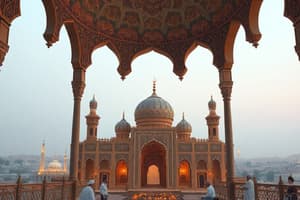Podcast
Questions and Answers
What is the name of the period in the Bronze Age that extended from 3200 B.C. to 2500 B.C., and was named after the tombs found in Jebel Hafeet near Al Ain?
What is the name of the period in the Bronze Age that extended from 3200 B.C. to 2500 B.C., and was named after the tombs found in Jebel Hafeet near Al Ain?
Jebel Hafeet Period
Which era saw the establishment of Portuguese control over the Indian Ocean and Arabian Gulf?
Which era saw the establishment of Portuguese control over the Indian Ocean and Arabian Gulf?
- Portuguese Era (correct)
- Dutch Era
- Union Era
- Islamic period
During the Bronze Age, the Umm al Nar period represented the beginning of the Iron Age civilization in the UAE.
During the Bronze Age, the Umm al Nar period represented the beginning of the Iron Age civilization in the UAE.
False (B)
The UAE area during the Iron Age was characterized by the introduction of _________ irrigation systems for continuous cultivation.
The UAE area during the Iron Age was characterized by the introduction of _________ irrigation systems for continuous cultivation.
Match the historical periods with their respective time ranges:
Match the historical periods with their respective time ranges:
Which countries were involved in commercial and political activities in Bandar Abbas?
Which countries were involved in commercial and political activities in Bandar Abbas?
In which year did the English East India Company establish its first factory on the Gulf coast in Bandar Abbas?
In which year did the English East India Company establish its first factory on the Gulf coast in Bandar Abbas?
The British concluded the General Treaty of Peace with the sheikhs of the Arab coast in 1820.
The British concluded the General Treaty of Peace with the sheikhs of the Arab coast in 1820.
The Exclusive Agreements of 1892 made it obligatory for the Trucial Sheikhs not to enter into agreement or correspondence with any power other than the __________ Government.
The Exclusive Agreements of 1892 made it obligatory for the Trucial Sheikhs not to enter into agreement or correspondence with any power other than the __________ Government.
Match the Emirates to their actions leading to the formation of the United Arab Emirates:
Match the Emirates to their actions leading to the formation of the United Arab Emirates:
Flashcards are hidden until you start studying
Study Notes
Prehistoric Times
- The Neolithic Age (6000 BC - 3500 BC) in the UAE region saw the first evidence of human settlement, with remains of Bedouin communities found.
- The Bronze Age (3200 BC - 1300 BC) in the UAE region was divided into four periods:
- Jebel Hafeet Period (3200 BC - 2500 BC): characterized by the introduction of copper industry and the discovery of mass graves and settlements in Al Ain, Abu Dhabi.
- Umm al Nar Period (2500 BC - 2000 BC): marked by the discovery of ruins on Umm al Nar Island, with finds including pottery fragments, copper tools, and bones of cattle, fish, and camels.
- Wadi Suq Period (2000 BC - 1300 BC): characterized by the decline of civilization, possibly due to harsh climatic changes or the end of the copper trade with Mesopotamia.
- Iron Age (1300 BC - 300 BC): saw the introduction of falaj irrigation systems, enabling continuous cultivation in the dry climate.
Islamic Era
- The area of UAE and Oman embraced Islam in either 629 or 632 AD, with the Prophet Mohammed sending an envoy to the region.
- The Ruling family (Al-Jalandi from Azad) accepted Islam after several back-and-forth missions to the region.
Portuguese Era
- In 1498, Vasco da Gama discovered the sea route to India, leading to the militarization of the Indian Ocean and Arabian Gulf and the establishment of Portuguese control over them.
Dutch Era
- The Dutch obtained a concession in Mocha, a Yemeni port on the Red Sea, and later concentrated their trade at Basra and Gombroon (modern Bandar Abbas) in the Gulf.
British Era
- The English East India Company was formed in 1600 and began trading in Persia through Jask in 1616.
- The Company succeeded in securing a monopoly of the silk trade from Persian ports in 1617.
- The British established their first factory on the Gulf coast in 1623 in Bandar Abbas.
- The British concluded the General Treaty of Peace with the sheikhs of the Arab coast in 1820, effectively giving them the right to police the seas of the lower Gulf.
Exclusive Agreements
- The Exclusive Agreements of 1892 made it obligatory for the Trucial Sheikhs not to enter into agreements or correspondence with any power other than the British Government.
Unification
- In 1968, the British Government announced it would terminate all its treaties with the nine Trucial States and withdrawal its forces from the Gulf by the end of 1971.
- Sheikh Zayed, Ruler of Abu Dhabi, and Sheikh Rashid bin Saeed Al Maktoum, Ruler of Dubai, initiated the first move towards establishing a federation.
- The first meeting for the unification took place between the Rulers of Abu Dhabi and Dubai on February 18, 1968, resulting in the "Union Accord".
- The seven-Emirate Union was formed on July 18, 1971, with the Rulers of Abu Dhabi, Dubai, Sharjah, Ajman, Umm Al Quwain, and Fujairah deciding to form the United Arab Emirates (UAE).
- Ras al Khaimah joined the UAE on February 10, 1972.
- Sheikh Zayed bin Sultan Al Nahyan was elected as the first President of the UAE, and Sheikh Rashid bin Saeed Al Maktoum as Vice President.
Studying That Suits You
Use AI to generate personalized quizzes and flashcards to suit your learning preferences.




